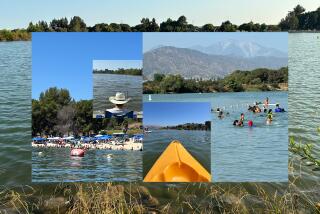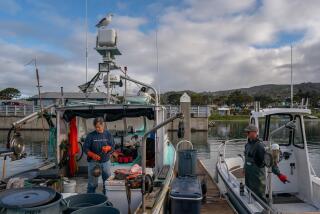Go Fish!
- Share via
It’s summertime, the living is easy and, due to heavy winter rains, fish are jumping and the water is high. The result? Orange County freshwater fishing conditions are the best they’ve been in years. To improve the odds of landing a few, read on.
*WHAT YOU’LL NEED sinkers bobbers hooks leaders fishing line lures Drinking water Hat Sunscreen Net Rags
* Hot Rod and Reel
Most fishing rods are made from light yet strong materials such as graphite, boron and fiberglass. Rods pull apart for storage. To ensure that the joint comes apart easily, rub axle grease on the ferrule before connecting rod.
Tip
Ferrule
Guides
Butt guide
Foregrip
Reel seat
Butt cap
* Reel
Spin-casting reels, which have a cover over the line, are least likely to jam or allow the line to tangle.
TECHNIQUE: HOW TO SNAG ONE Tying Knots Improved clinch knot Improved clinch knot (Also called fisherman’s knot) is easy to learn and very strong. It has many uses including tying lines or leaders to hookds, lures, jigs or swivels.
* Baiting a Hook
Use salmon eggs in clusters, three on a treble hook. Be sure the eggs. Be sure the eggs are seated firmly on barbs.
Thread hook through worm twice to ensure it doesn’t wiggle free.
* TROUT:
The best-size hooks and bait used to catch Orange County’s most common freshwater fish: Hook No. 12 (treble hook). Bait: Power Bait, salmon eggs, artificial lures. Best fishing: Pre-dawn to dawn.
* BASS Hook No. 6 Bait: Night crawlers. Best fishing: Early morning or late afternoon: near bottom hiding in weeds, along shoreline.
* CATFISH Hook: Nos. 1-4 Bait: Cut mackerel, dough bait, cut liver. Best fishing: Early morning or evening best from midnight to 3.a.m.
* CRAPPIE Hook: No. 10. Bait: Meal Worms, crickets, Crappie jigs. Best fishing: Early morning or Evening often near pier pilings.
* Think Like a Fish: Morning
Successful fishing is directly linked to knowing where fish feed, so, to catch fish, you have to think like a fish. Fortunately, thinking like a fish is relatively easy because, just like people, fish like structure. That is, fish always take the same routes at the same times to their favorite eateries. (Think of it as walking down a series of hallways to get to the office cafeteria, except fish might take a left at the old sunken tire instead of at the old broken water cooler.)
Mornings are best to try surface fishing for trout and bass; both eat insects that float on the glassy morning surface. As the sun rises, trout and bass will drop to the lake bottom not only to escape the warmer water but to move away from sunlight. Summer bass fishing will be most successful with Rapala lures; salmon eggs work best for trout. For the best results, use a light line on both fish, vary the speed of reeling in the hook and try a variety of baits and lures before packing up your gear: these fish can be finicky.
*Evening
Late afternoons and evenings are great times to catch crappie and catfish. While both varieties prefer deeper waters during hot summer days, as the sun crosses into late afternoon, they glean through reeds and brush the surface for insects. For panfish, like crappie, use a light line (4-5 pounds is best) with small marabou jigs or small hooks baited with grubs.
Catfish, however, have large mouths and weigh in at a couple of dozen pounds. To keep the line or hook from breaking, use a 10-20 pound fishing line and large hooks. Unlike trout and bass, catfish will eat almost anything . . . usually the stronger the stench, the better. They’ll hit on worms and grubs, but fish-based wet cat foods, chunks of canned tuna or mashed sardines are among the most effective catfish baits on the market. To know how fish think not only takes practice, patience and knowing the terrain of the lake or river bottom, successful fishing also relies on knowing when fish feed and what their dining preferences are.
Casting 1) Make sure fishing line isn’t tangled at tip section or on guides. 2) Check for people behind you; avoid casting under low-hanging trees. 3) Hold rod out in front, press thumb on stop and hold in. 4) Swing rod up and slightly over head. 5) Bring rod down; release thumb stop about halfway through movement. Caution: Releasing thumb too soon will result in popping up the line; waiting too long to release will result in a short cast.
* Hooking 1) As soon as you feel the line pull or see the bobber drop under the water, give the line a quick tug. 2) Play the fish by bringing rod tip up, then lowering it back down while reeling in.
* Landing Fish 1) Small fish: Lead fish in head first while reeling in. 2) Large fish: Use net to avoid breaking line. To remove hook, hold fish firmly behind gills and use needle-nose pliers to grasp hook.
* Fewer Licenses Issued The Department of Fish and Game has been issuing fewer fishing licenses in the past five years in Orange County. But with this year’s full streams and lakes, the number of licenses is expected to rise.
*
Resident Non-resident One-day (annual) (annual) only Total 1988 61,787 38 3,790 65,615 1989 57,448 281 3,212 60,941 1990 51,152 283 3,739 55,174 1991 50,317 204 3,280 53,801 1992 49,160 18 3,186 52,364
Cost of Licenses
Only those 16 years and older are required to have a fishing license. Licenses can be purchased at most bait shops and fishing departments of major department or sporting goods stores or, with a MasterCard or Visa, directly from the Department of Fish and Game by calling (916) 227-2244. *Type of license: Cost* Resident (annual): $23.90 Non-resident (annual): 64.30 Resident/non-resident one-day: 8.40
* * Reduced fees are available for disabled veterans and seniors on limited incomes.
Glossary
Afternoon bite: When the fishing is good, from 3 to 6 p.m.
Angling: Catching a fish in such a manner that the fish voluntarily takes the bait or lure in its mouth.
Catch-and-release fishing: The practice of humanely catching and releasing fish for sport.
Fish on: Fish has taken bait and is hooked.
Waste of fish: It is unlawful to cause or permit any deterioration or waste of any fish taken in the waters of this state.
Sources: Department of Fish and Game, World Book Encyclopedia, The Complete Book of Fishing; researched by APRIL JACKSON and CHUCK NIGASH / Los Angeles Times


